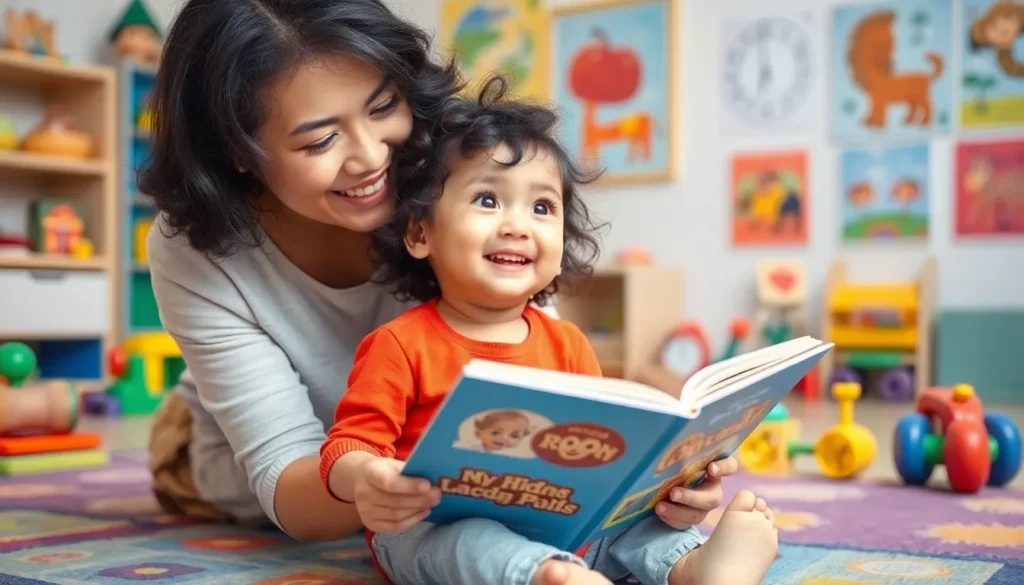Table of Contents
ToggleLanguage is the magic wand that opens up a world of communication. Whether it’s a toddler babbling their first words or an adult mastering a new language, the journey of language development is nothing short of fascinating. But let’s face it—navigating this journey can feel like trying to teach a cat to fetch.
Importance Of Language Development
Language development serves as a cornerstone for effective communication. It plays a vital role in social interactions and academic success. Early exposure to language fosters cognitive growth, enhancing critical thinking and problem-solving skills.
Rich language environments contribute significantly to a child’s linguistic abilities. Interaction with caregivers and peers stimulates vocabulary expansion. Engaging in conversations often boosts comprehension and fluency, aiding both verbal and written skills.
Research highlights the link between language proficiency and literacy. Children with strong language foundations tend to excel in reading and writing. Regularly reading to children introduces them to new words and sentence structures, reinforcing their language knowledge.
Effective communication skills are crucial in various settings. Language development shapes a person’s ability to express thoughts and emotions clearly. This skill set is essential for building relationships and navigating social contexts.
Listening skills also intertwine with language development. Listening actively helps individuals understand nuances in conversations, fostering empathy and emotional intelligence. Developing these skills early can lead to more meaningful interactions.
Educational programs focused on language development have demonstrated improved outcomes. Early childhood education that emphasizes language-rich activities significantly enhances children’s overall learning experiences. Such initiatives prepare children for future academic pursuits and lifelong learning.
Fostering language development requires patience and consistency. Encouraging frequent conversations, storytelling, and interactive play creates an optimal environment for growth. By emphasizing the importance of language development, caregivers and educators support children in reaching their full potential.
Key Stages Of Language Development

Understanding the key stages of language development helps caregivers support children’s growth effectively.
Infancy
Infants demonstrate remarkable abilities in language acquisition from birth. They begin by cooing and babbling at around two to three months, transitioning to producing recognizable sounds by six months. Listening to phonetic variations, they learn to differentiate between sounds. Responding to caregiver cues fosters early conversational exchanges. Engaging in activities like singing and reading aloud enriches their linguistic exposure. This environment nurtures sound recognition, laying a foundation for future speech.
Toddlerhood
During toddlerhood, children expand their vocabulary rapidly. By age two, many express about 50 words and start combining them into simple phrases. Fluctuating between single words and multi-word utterances, they demonstrate growing communication skills. Daily interactions, such as asking questions and playing, significantly enhance language proficiency. Encouragement and responsiveness from caregivers further boost vocabulary development. Exposure to diverse language experiences, like storytelling and rhyming games, supports their language journey.
Preschool Age
Language development continues to thrive during preschool age. Children often speak in full sentences and understand complex instructions. Expanding vocabulary to 1,000 words or more facilitates richer conversations. Role-playing and imaginative play encourage creative language use. Engaging in discussions about books fosters comprehension and narrative skills. They begin to grasp grammar rules, refining their speech patterns. Consistent interactions with peers and adults contribute to their linguistic confidence.
Effective Language Development Tips
Enhancing language development involves strategic, engaging methods that foster communication skills.
Reading Aloud
Reading aloud plays a vital role in language development. Exposure to various types of literature introduces children to new vocabulary and sentence structures. Diverse stories stimulate imagination and comprehension skills. Engaging children with questions about the story enhances critical thinking. Consistent reading routines, such as bedtime stories, reinforce language connections. Parents notice that discussing illustrations prompts conversations, encouraging expressive language use.
Encouraging Conversations
Encouraging conversations boosts language development significantly. Open-ended questions invite children to express their thoughts and feelings. Active listening models effective communication, demonstrating how to respond appropriately. Allowing children to lead discussions builds confidence and vocabulary. Daily interactions during activities, like meal prep or playtime, increase opportunities for dialogue. Using prompts, such as “What do you think will happen next?” nurtures curiosity and engagement.
Using Visual Aids
Using visual aids enhances understanding and retention of language concepts. Colorful charts, images, and flashcards make learning appealing and interactive. Associating words with images solidifies comprehension, making abstract concepts tangible. Visual schedules aid in following routines and developing sequencing skills. Incorporating everyday items, like toys or books, into discussions fosters contextual learning. With consistent practice, children expand their vocabulary and communication skills effectively.
Common Challenges In Language Development
Language development presents various challenges. Identifying these issues early can significantly aid support efforts.
Delayed Speech
Delayed speech occurs when a child lags behind peers in verbal skills. Children with delayed speech may struggle to express their thoughts, leading to frustration. As an example, some toddlers might use fewer than 50 words by age two. Timely intervention from speech therapists or educators can help address these delays. Engaging in frequent conversations and reading aloud can foster language skills. Parents and caregivers should monitor progress and seek professional advice if a child shows signs of significant delay.
Speech Disorders
Speech disorders encompass various conditions affecting clarity and fluency. Some children may experience stuttering, characterized by interruptions in speech flow. Articulation disorders involve difficulty pronouncing sounds correctly, which can hinder effective communication. Many factors contribute to speech disorders, including genetics and environmental influences. Treatment often includes speech therapy tailored to individual needs. Encouraging positive reinforcement and patient communication helps children feel more secure while expressing themselves. Implementing supportive environments promotes confidence, enabling improvement in speech capabilities.
Language development is a vital journey that shapes a child’s ability to communicate and connect with the world. By fostering rich language environments and employing effective strategies, caregivers can significantly enhance a child’s linguistic skills. Early intervention and support play crucial roles in addressing challenges that may arise along the way. As children grow and refine their communication abilities, they become better equipped for academic success and meaningful social interactions. Prioritizing language development not only benefits children in their formative years but also lays a strong foundation for lifelong learning and personal growth.







